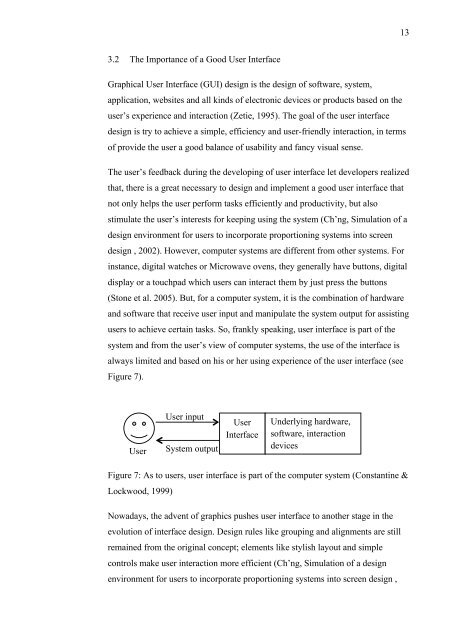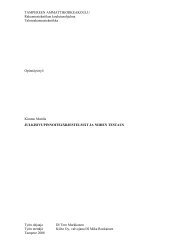user interface design by applying theories of aesthetics - Theseus
user interface design by applying theories of aesthetics - Theseus
user interface design by applying theories of aesthetics - Theseus
You also want an ePaper? Increase the reach of your titles
YUMPU automatically turns print PDFs into web optimized ePapers that Google loves.
13<br />
3.2 The Importance <strong>of</strong> a Good User Interface<br />
Graphical User Interface (GUI) <strong>design</strong> is the <strong>design</strong> <strong>of</strong> s<strong>of</strong>tware, system,<br />
application, websites and all kinds <strong>of</strong> electronic devices or products based on the<br />
<strong>user</strong>’s experience and interaction (Zetie, 1995). The goal <strong>of</strong> the <strong>user</strong> <strong>interface</strong><br />
<strong>design</strong> is try to achieve a simple, efficiency and <strong>user</strong>-friendly interaction, in terms<br />
<strong>of</strong> provide the <strong>user</strong> a good balance <strong>of</strong> usability and fancy visual sense.<br />
The <strong>user</strong>’s feedback during the developing <strong>of</strong> <strong>user</strong> <strong>interface</strong> let developers realized<br />
that, there is a great necessary to <strong>design</strong> and implement a good <strong>user</strong> <strong>interface</strong> that<br />
not only helps the <strong>user</strong> perform tasks efficiently and productivity, but also<br />
stimulate the <strong>user</strong>’s interests for keeping using the system (Ch’ng, Simulation <strong>of</strong> a<br />
<strong>design</strong> environment for <strong>user</strong>s to incorporate proportioning systems into screen<br />
<strong>design</strong> , 2002). However, computer systems are different from other systems. For<br />
instance, digital watches or Microwave ovens, they generally have buttons, digital<br />
display or a touchpad which <strong>user</strong>s can interact them <strong>by</strong> just press the buttons<br />
(Stone et al. 2005). But, for a computer system, it is the combination <strong>of</strong> hardware<br />
and s<strong>of</strong>tware that receive <strong>user</strong> input and manipulate the system output for assisting<br />
<strong>user</strong>s to achieve certain tasks. So, frankly speaking, <strong>user</strong> <strong>interface</strong> is part <strong>of</strong> the<br />
system and from the <strong>user</strong>’s view <strong>of</strong> computer systems, the use <strong>of</strong> the <strong>interface</strong> is<br />
always limited and based on his or her using experience <strong>of</strong> the <strong>user</strong> <strong>interface</strong> (see<br />
Figure 7).<br />
User<br />
User input<br />
System output<br />
User<br />
Interface<br />
Underlying hardware,<br />
s<strong>of</strong>tware, interaction<br />
devices<br />
Figure 7: As to <strong>user</strong>s, <strong>user</strong> <strong>interface</strong> is part <strong>of</strong> the computer system (Constantine &<br />
Lockwood, 1999)<br />
Nowadays, the advent <strong>of</strong> graphics pushes <strong>user</strong> <strong>interface</strong> to another stage in the<br />
evolution <strong>of</strong> <strong>interface</strong> <strong>design</strong>. Design rules like grouping and alignments are still<br />
remained from the original concept; elements like stylish layout and simple<br />
controls make <strong>user</strong> interaction more efficient (Ch’ng, Simulation <strong>of</strong> a <strong>design</strong><br />
environment for <strong>user</strong>s to incorporate proportioning systems into screen <strong>design</strong> ,
















